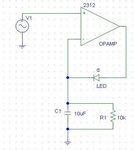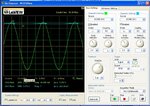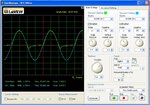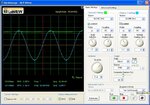eckaman
Newbie level 3
Hi everyone,
I made a half wave rectifier with a single op amp and LED and made a filter with a cap and resistor as shown.

At low frequencies this works without a problem. The DC voltage across the resistor and cap is exactly equal to the peak of the input signal. But at 50kHz, the voltage across the cap and resistor has been attenuated by something (pic below).

This attenuation decreases for lower input voltage and lower frequency. I don't think it's a problem with the scope input impedance, because I'm measuring a DC signal. Unless the output impedance of my circuit increases with input voltage and frequency.
Does anyone know what is causing the drop?
Thanks!
I made a half wave rectifier with a single op amp and LED and made a filter with a cap and resistor as shown.

At low frequencies this works without a problem. The DC voltage across the resistor and cap is exactly equal to the peak of the input signal. But at 50kHz, the voltage across the cap and resistor has been attenuated by something (pic below).

This attenuation decreases for lower input voltage and lower frequency. I don't think it's a problem with the scope input impedance, because I'm measuring a DC signal. Unless the output impedance of my circuit increases with input voltage and frequency.
Does anyone know what is causing the drop?
Thanks!

